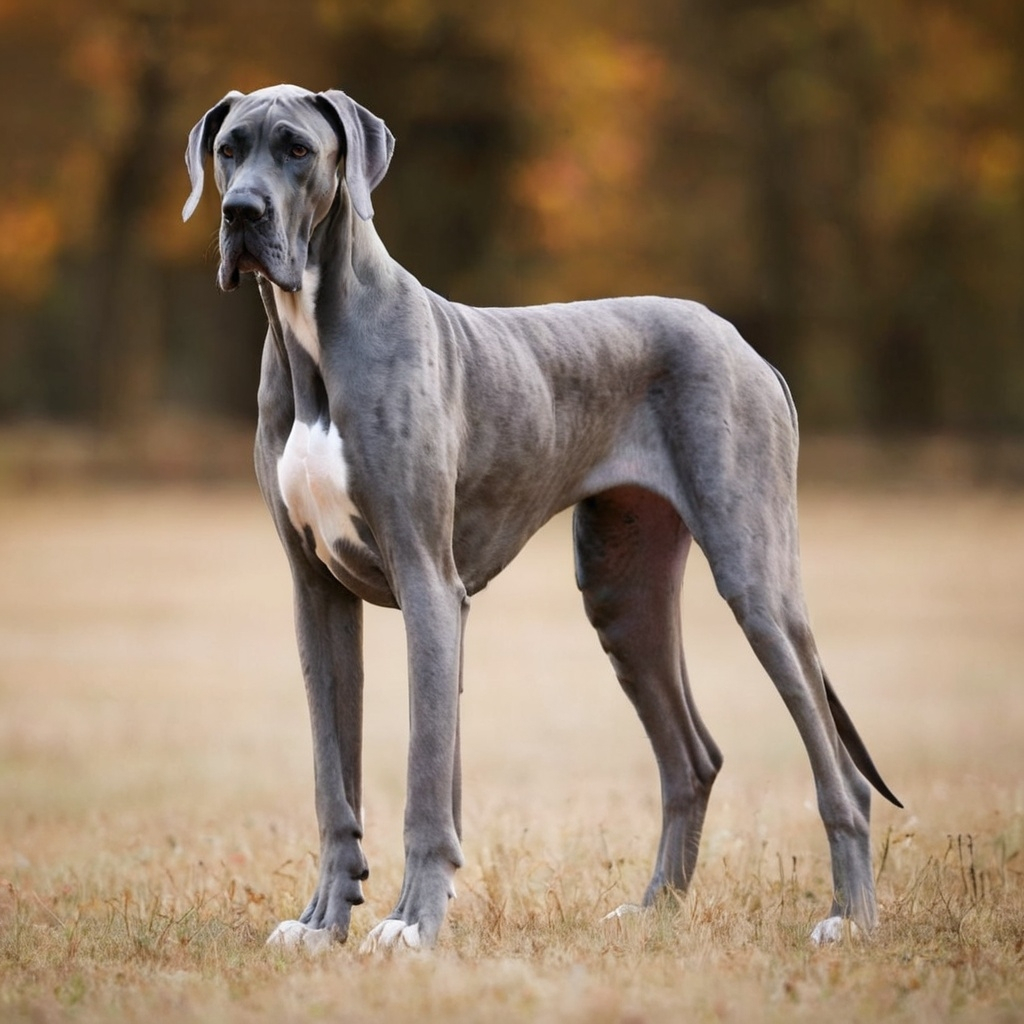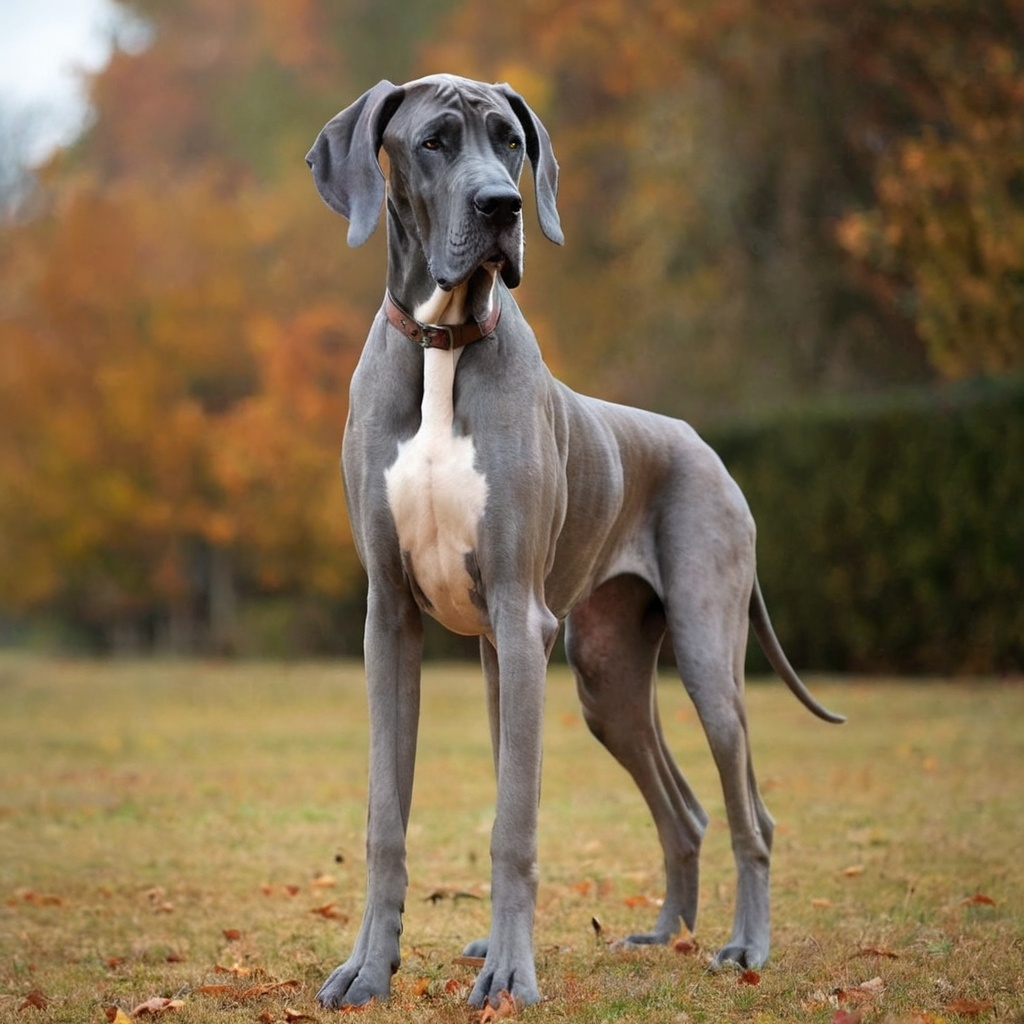The Great Dane is a wonderful companion, devoted to the family, slow to anger and ready to accept other pets. Despite its size it does not object to apartment life, provided it has plenty of walks. It is easily trained. Regrettably this is a breed that is not renowned for its longevity.

Origin and history
The Great Dane has existed in the United Kingdom for many centuries and is thought to be a descendant of the Molussus hounds of Roman times. In the Middle Ages they were used to chase wild boa” to bait bulls and to guard their master.
Interest in the breed was roused in Germany in the 1800s by Bismarck, who had a penchant for the Mastiff. By crossing the Mastiff of southern Germany and the Great Dane of the north early devotees produced a Dane similar to the type known today. It was first exhibited at Hamburg in 1863, being shown under the separate varieties of Ulmer Dogge and Danisch Oogge. In 1876, it was decided that they should be shown under the single heading of Deutsche Dogge, and they were acclaimed as the national dog of Germany. This breed is sometimes referred to as the Apollo of the dog world.
Great Dane Puppies
Good points
- Devoted
- Gets on with other animals
- Good-natured
- Easy to train
- Family dog
Take heed
- Not the dog to have a rough and tumble with – it might take you seriously
- Not renowned for longevity
Size
Minimum height: dog 30in (76cm); bitch 28in (71cm). Weight: dog 120lb (54.4kg); bitch 100lb (45.4kg).
Exercise
Regular exercise on hard ground.

Great Dane Information
General appearance
the Great Dane should be remarkable in size and very muscular, strongly though elegantly built; the head and neck should be carried high and the tail in line with the back or slightly upwards but not curled over the hindquarters. Elegance of outline and grace of form are most essential to a Dane; size is absolutely necessary, but there must be that alertness of expression and briskness of movement without which the Great Dane character is lost. It should have a look of dash and daring, of being ready to go anywhere and do anything. The action should be lithe, springy and free, the hocks move freely, and the head be carried high except when galloping.
Colour
Brindles must be striped, ground colour from the lightest yellow to the deepest orange, and the stripes must always be black; eyes and nails preferably dark. Fawns, varying from lightest buff to deepest orange; darker shadings on the muzzle and ears and around the eyes are by no means objectionable; eyes and nails preferably dark. Blues, varying from light grey to deepest slate. Black. (In all the above colours, white is admissible only on the chest and feet, but it is not desirable even there. The nose is always black, except in blues. Eyes and nails preferably dark.) Harlequins, pure white ground with preferably black patches (blue patches are permitted), having the appearance of being torn. In harlequins, wall eyes, pink noses or butterfly noses are permissible but not desirable.
Head and skull
The head, taken altogether, should give the idea of great length and strength of jaw. The muzzle or foreface is broad and the skull proportionately narrow, so that the whole head, when viewed from above and in front, has the appearance of equal breadth throughout. The entire length of head varies with the height of the dog; 13in (33cm) from the tip of the nose to the back of the occiput is a good measurement for a dog of 32in (81cm) at the shoulder. The length from the end of the nose to the point between the eyes should be about equal to, or preferably of greater length than, that from this point to the back of the occiput. The skull should be flat and have a slight indentation running up the centre, the occipital peak not prominent. There should be a decided rise or brow over the eyes but no abrupt stop between them; the face should be well chiselled, well filled in below the eyes with no appearance of being pinched; the foreface long, of equal depth throughout. The cheeks should show as little lumpiness as possible, compatible with strength. The underline of the head, viewed in profile, should run almost in a straight line from the corner of the lip to the corner of the jawbone, allowing for the fold of the lip, but with no loose skin to hang down. The bridge of the nose should be very wide with a slight ridge where the cartilage joins the bone. (This is a characteristic of the breed.) The nostrils should be large, wide and open, giving a blunt look to the nose. A butterfly or flesh-coloured nose is not objected to in harlequins. The lips should hang squarely in front, forming a right angle with the upper line of the foreface.
Body
The long, sinewy neck is firm and clean with a high arch. The chest is quite broad, deep and well muscled. The ribs are well sprung and flattened at the side to allow for proper movement. The back is short and tensely set. The belly is well shaped and tightly muscled. The gait is characterized by a long, springy, easy stride with no rolling of the body.
Tail
Should be thick at the root and taper towards the end, reaching to or just below the hocks. It should be carried in a straight line level with the back; when the dog is in action, the tail may be slightly curved towards the end, but in no case should it curl or be carried over the back.
Feet
These should be cat-like, and should turn neither in nor out. The toes well arched and close; nails strong and curved. Nails should be black but light nails are permissible in harlequins.
Great Dane Feeding & Grooming
Grooming
Regular grooming with a body brush. NB: the Great Dane needs warm sleeping quarters.
Feeding
Recommended would be 20-330z (587-936g) of a branded, meaty product with biscuit added, or 3-5 cupfuls of a dry food, complete diet, mixed in the proportion of 1 cup of feed to V2 cup of hot or cold water.
